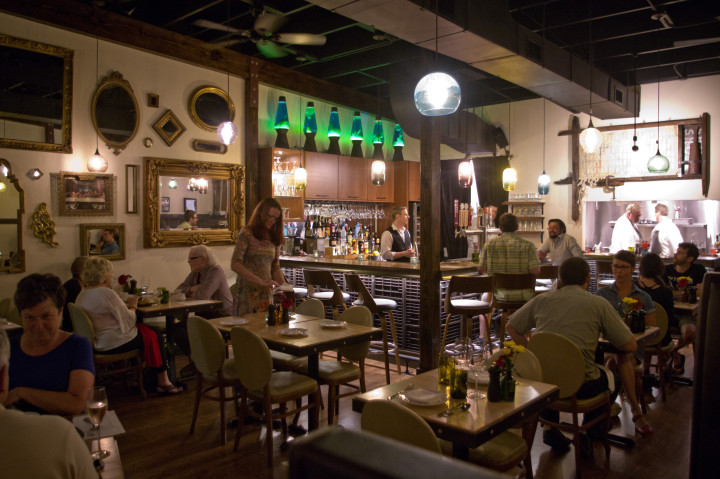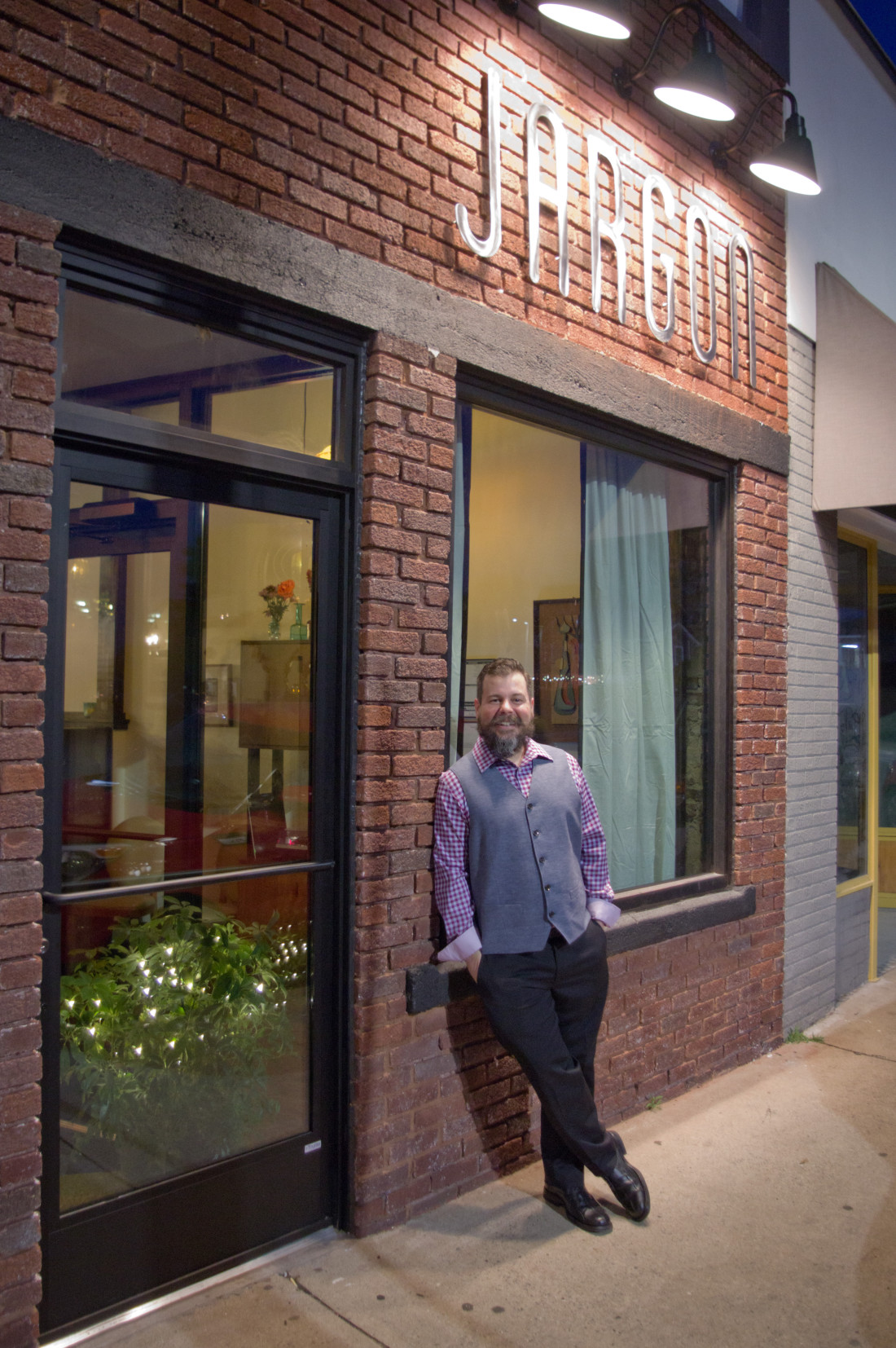The setting late-spring sun presses against the brown paper still covering the windows at 715 Haywood Road, giving the room inside an orange glow. Just two weeks away from its May 18 debut as a restaurant, the space looks a bit different from when it was the gray- and red-brick Schultz Shoe Shop. Completely gutted, with only the facade remaining, the building, which has transformed into a 49-seat eatery called Jargon, now has a basement, a flagstone patio and a floor-to-ceiling glass entryway.
“I like the definition of jargon of ‘repurposed language,’” says owner Sean Piper, a California film industry veteran-turned-restaurateur. “It is a language that only certain people understand. It’s an inclusive thing that anyone can learn, but there’s also an exclusivity to it.”
And from the looks of things inside, Piper likes repurposed culture as well as words. There are Mexican glass pendants made into chandeliers; a colorful floor mosaic made by his wife, Shelley Piper; tabletops made by Christopher Perryman of Goldsplinter Woodworking Studio from 1950s Indiana bowling alleys; vintage 1960s chairs; classic high-topped booths and a bar lined with antique Hamilton printers trays. Even the restaurant’s 300 water glasses are upcycled art, all made by hand from recycled wine bottles by Piper, his friends and staff.
With nearly 80 credits to his name for his work as a grip, or camera technician, on IMDb movies, including The Hunger Games, Captain America: Civil War, and the Oscar-nominated Loving, Piper has never run a restaurant before. But he, like many others, has decided to try his hand at something new in Asheville’s booming foodie market.
Capital idea
“It’s really scary, all the money going out,” he says. The sound of nail guns punctures his speech, and just over his shoulder, a cleaning crew is detailing the windows. Piper has clearly spent a lot of money getting the place to this point. “I just wanted to do something that no one else is doing.”
Piper opted to feel his way along with the menu at first. “We’re going to start out small and then expand it,” he says. Jargon launched with a menu of about 16 items from chef Matthew Miner — mostly small plates, a few entrée options, a crossover late-night menu and Sunday brunch.

Dishes show a multitude of influences, including Southern U.S., Asian, French and Caribbean. Deep-fried deviled eggs, General Tso’s quail with forbidden rice and baby bok choy and a ramen noodle bowl with smoked dashi, pork, scallions, egg and Peppadews.
“An old mentor of mine told me that if I was going to do this, I needed to make sure I owned the building, and it took me 4 1/2 years to find one,” he observes, noting that in Asheville, commercial real estate is a particularly tricky market.
To buy his building, the seller required him to pay cash. So he spent his life’s savings and borrowed money from his father. But that only got him through acquiring the building. Financing the restaurant business itself was another hurdle. Banks turned him away because his idea was a startup, because he was a restaurant newbie and even because he did not have any more capital of his own. But eventually he found a bank willing to pony up and back his project.
“Operating capital is one of the most important things when you are opening a restaurant,” agrees Patrick O’Cain, chef and owner of Gan Shan Station, who is currently working to open his second location in West Asheville next to Pizza Mind. “The last thing you want to be thinking about when you are opening a new place and figuring out all the little details is cash flow and wondering if you are going to be able to make payroll,” he says. “I suggest having at least three months of capital before you even open.”
Devil in the details
Throughout the development, construction and opening process, these entrepreneurs also have to maintain a close relationship with the fire marshal, health inspector and the city’s Planning and Zoning Department. Before construction starts, restaurateurs must submit their plans to the city for approval. From there, they are assigned an inspector who oversees the construction process and works with the architect and contractor to ensure that everyone is interpreting the building code the same way.
For Piper, completing some of those steps caused delays that added up to more expense. “It can be a little frustrating,” he says. “We have had three pre-inspections, and they just really don’t seem to be on the same page. For instance, by code, 18 inches from any combustible surface, you have to have stainless steel. So around our oven, we outfitted it all with stainless steel. But less than a week ago, the inspector said we had to coat around the hood too. So we had to go back and do it, and now the entire ceiling there is wrapped in stainless steel. There’s no consistency.”
Diane Meek, the city of Asheville’s interim director of Development Services, says that while public health and safety are the city’s primary concern when it comes to the permitting process, Development Services Department staff do their best to be “as consistent as possible with the enforcement of the minimum requirements of the State Building Codes.” The city also advises restaurateurs to hire design professionals and licensed contractors with experience in restaurant construction.
Meek stresses that the codes have an important purpose. “These codes are intended to protect the health and safety of the public and the welfare of the business owner,” she says.
“Most architects work in phases, and there is always more than one submission to the city to get those plans approved, and you end up waiting a lot.” O’Cain says, pointing out that the city has been backed up to about a four- to six-week wait for plan approvals due to the boom in construction around town. His new venture plans to focus on affordable dumplings and noodles, and he hopes to have the restaurant and takeout window open by the end of the summer, but the process is so unpredictable that he isn’t willing to say for sure just when he’ll fire up the stove. “I certainly sympathize with the city’s position. They have a very small amount of people doing a lot of work.”
Waiting is part of the game, says O’Cain. “Most architects work in phases, and there is always more than one submission to the city to get those plans approved,” he says, pointing out that the wait for plan approvals from the city has been backed up due to the recent boom in construction. His new venture plans to focus on affordable dumplings and noodles, and he hopes to have the restaurant and takeout window open by the end of the summer, but the process is so unpredictable that he isn’t willing to say for sure just when he’ll fire up the stove. “I certainly sympathize with the city’s position. They have a very small amount of people doing a lot of work.”
Meek says that while the city’s goal is to provide the first round of review comments on a project within 10-15 days, the time frame can be longer. “The total process time for a restaurant can vary based on the completion of the submittal and the site-specific details that must be worked through,” she explains. She notes that the city offers a Restaurant Startup Guide that outlines permitting and licensing information as well as the option to schedule a meeting with code officials before starting the process.
Once the inspections are wrapped up and all the proper certificates have been awarded, it is a matter of going through the final health inspections and opening the doors. Which is, in reality, when the truly difficult work begins. Opening weeks — particularly when fumbled — can leave lasting impressions on guests. “Chef and I decided not to have a grand opening,” says Piper. “We’d rather put some grease on the wheels first before we ruin a first impression.” Jargon opened quietly on May 18 after two evening preview dinners.
It is said that in the restaurant industry, which has one of the highest failure rates of any small business, there are a thousand ways to fail and all of them come down to details. Which may help explain why it’s not uncommon to see one restaurant go bust while the one next door starts expanding. “There’s always a solution to a problem; you can’t just freak out,” says Piper. “We’ve hit things that feel like walls, but there’s really always a way to get through them.”
Jargon is at 715 Haywood Road. Temporary hours are 5-10 p.m. Monday-Sunday for dinner, 10 p.m.-2 a.m. Monday-Sunday for late-night and 10 a.m.-3 p.m. Sunday for brunch. For details and to make reservations, visit jargonrestaurant.com.
Gan Shan Station is at 143 Charlotte St. Gan Shan West is scheduled to open this summer at 285 Haywood Road. For details, visit ganshanstation.com or look for Gan Shan West on Facebook.




Big Ouch.
I certainly wish our newbie, budding restaurateur well, but….wow, does this guy like to layer on the risk. He’s got himself boxed-in pretty tightly. An indicator of an economy top?